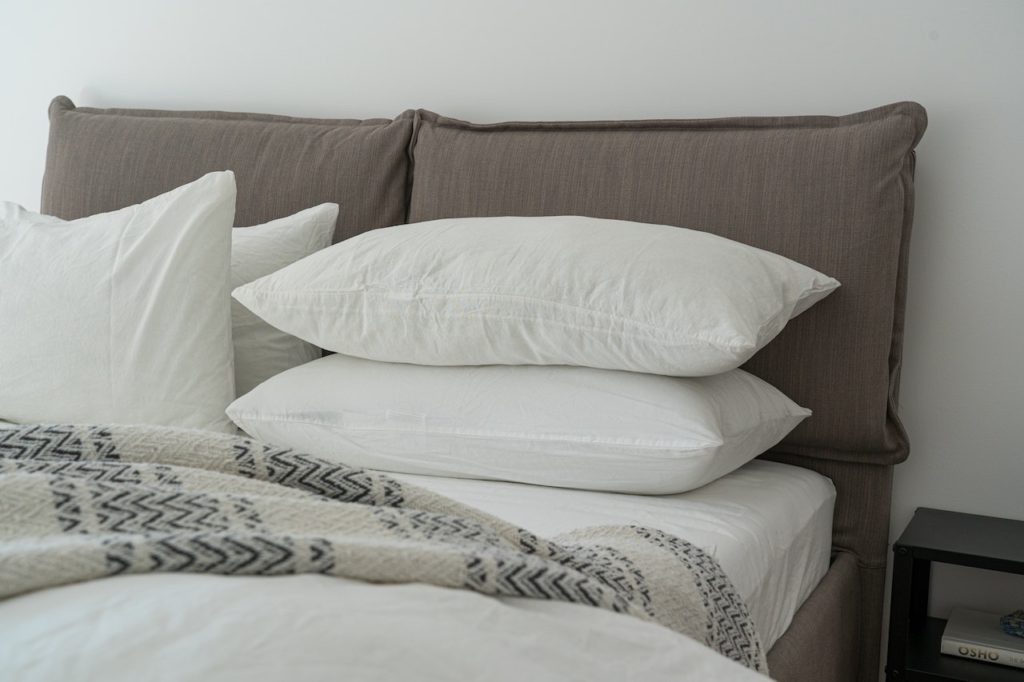Eco friendly bedding and mattresses have become vital today because in our world, environmental concerns are at the forefront, creating a sustainable lifestyle has become a priority for many individuals.
Often, we overlook the bedroom in this quest for sustainability. We can still positively impact the environment by choosing the right bedding and mattress. Every decision can contribute to a greener and more sustainable future – from the materials used to the manufacturing process.
How can Eco Friendly Bedding and Mattresses Promote Sustainability?
Bedrooms are where we spend most of our time. That is why bedding and mattresses are crucial. We can minimize our ecological footprint and reduce our exposure to harmful chemicals if we choose eco-friendly options.
In addition to using sustainable materials and promoting responsible manufacturing practices, the design of eco friendly bedding and mattresses has the environment in mind. These products benefit the environment and our health by promoting a healthier sleep environment.
What are Eco Friendly Bedding and Mattresses?
Eco friendly bedding and mattresses are products that are designed and manufactured with a focus on minimizing their environmental impact. They are made from sustainable materials, produced using eco-conscious practices, and often have certifications to validate their sustainability claims.
Benefits of Eco-Friendly Bedding and Mattresses
- Reduces environmental impact
Compared to conventional bedding and mattresses, eco-friendly alternatives come from renewable resources. During production, they minimize pollution and conserve natural resources.
- Healthier sleep environment
Chemicals and toxins in conventional bedding and mattresses can affect indoor air quality. Using eco-friendly materials minimizes the risk of exposure to harmful substances while sleeping.
- Supports sustainable practices
Eco-friendly products contribute to the demand for sustainable materials and responsible manufacturing practices, which drives positive changes in the industry.
What to Look For When Choosing Eco Friendly Bedding and Mattresses

1. Organic and natural fibers
Buy organic cotton, linen, bamboo, or hemp bedding. These materials are grown without synthetic fertilizers or pesticides, making them better for the environment and reducing exposure to harmful chemicals.
2. Recycled and upcycled materials
Bedding and mattresses from recycled or upcycled materials help reduce waste and promote a circular economy. Choose products made with recycled fibers or repurposed materials.
3. Non-toxic and low-emission certifications
Certified bedding and mattresses for non-toxicity and low emissions meet strict criteria such as Global Organic Textile Standard (GOTS) and OEKO-TEX Standard 100. In addition to being safe for the environment, these certifications are also safe for human health.
Tips on Choosing Eco-Friendly Bedding
A. Sustainable fabric choices
- Organic cotton
Buy bedding made from organic cotton, grown without synthetic fertilizers or pesticides. Organic cotton is a sustainable material that is soft and comfortable for a good night’s sleep.
- Bamboo
Bamboo bedding is gaining popularity due to its sustainable properties. Bamboo is a fast-growing and renewable resource that requires minimal water and pesticides. Go for bedding made from bamboo fibers that are processed using eco-friendly methods.
- Hemp
Hemp is a highly sustainable material known for its durability and breathability. It requires fewer pesticides and water compared to conventional cotton. Bedding made from hemp fibers is naturally hypoallergenic and can provide a comfortable sleep experience.
B. Eco-friendly dyes and finishes
Consider eco-friendly bedding that uses natural or low-impact dyes and finishes. Traditional textile dyes often contain harmful chemicals that can harm the environment and human health. Eco-friendly dyes and finishes minimize the release of toxins into the ecosystem.
C. Avoiding harmful additives and chemicals
Choose eco-friendly products free from harmful additives such as formaldehyde, flame retardants, and volatile organic compounds (VOCs). These substances in some conventional bedding products negatively affect indoor air quality and overall health.
D. The importance of ethical manufacturing processes
Look for eco-friendly bedding brands that prioritize ethical manufacturing processes. This includes fair labor practices, safe working conditions, and responsible waste management. Brands that promote transparency and accountability in their supply chain are more likely to prioritize sustainability. Consumers can create a more sustainable and eco-friendly sleep environment.
Tips on Selecting an Eco Friendly Mattress

A. Materials with low environmental impact
- Natural latex
The sap of rubber trees is a renewable source used to make natural latex mattresses. Look for products that use 100% natural latex, as synthetic latex may contain petroleum-based materials. Natural latex is durable, provides excellent support, and is resistant to dust and mold.
- Organic wool
Eco-friendly mattresses containing organic wool provide natural temperature regulation and moisture-wicking properties. Organic wool comes from sheep raised humanely and sustainably, without pesticides or synthetic chemicals.
- Sustainable wood frames
Consider eco-friendly mattresses with frames made from sustainably sourced wood, preferably certified by the Forest Stewardship Council (FSC). This ensures that the wood comes from responsibly managed forests and helps combat deforestation.
B. Certifications to look for
- Global Organic Textile Standard (GOTS)
Look for eco-friendly mattresses that have GOTS certification for the fabric components. GOTS ensures that the materials used meet strict organic and environmental criteria.
- Global Organic Latex Standard (GOLS)
If you opt for a latex mattress, GOLS certification ensures that the latex used is derived from organic sources and processed using eco-friendly methods.
- Forest Stewardship Council (FSC)
Look for FSC certification for wooden mattress frames. FSC certification guarantees that the wood is sustainable, promoting responsible forestry practices.
C. Avoiding flame retardants and other harmful chemicals
The flame-retardant chemicals in conventional mattresses can harm both humans and the environment. Consider products made from natural flame-retardant materials, such as wool, to avoid these chemicals.
The mattress industry can be prone to greenwashing, so it’s essential to research and read product labels. Manufacturers may claim to be eco-friendly without providing adequate evidence or certification. Third parties usually verify how sustainable a mattress is.
Other Sustainable Bedroom Considerations
1. Pillows and cushions
- Natural fillings
Opt for pillows and cushions filled with natural materials such as organic cotton, kapok, or buckwheat hulls. These materials are renewable and biodegradable, reducing environmental impact.
- Organic covers
Choose pillow and cushion covers made from organic fabrics, such as organic cotton or linen. The manufacturing process of organic covers doesn’t use harmful chemicals.
2. Bed frames and furniture
- Sustainable materials
Look for bed frames and bedroom furniture made from sustainably sourced wood or bamboo. Avoid furniture made from endangered or illegally harvested wood species.
- Reclaimed or upcycled furniture
Consider using reclaimed or upcycled furniture, which gives new life to existing pieces and reduces the demand for new resources.
3. Responsible disposal and recycling options
Look for ways to dispose of and recycle bedding and mattresses when replacing them. The manufacturer may offer a take-back program or recycling services to recycle old mattresses and their components.
4. Sustainable cleaning and maintenance practices
- Non-toxic cleaning products
Use non-toxic, eco-friendly cleaning products to clean bedding, mattresses, and bedroom furniture. This reduces exposure to harmful chemicals and minimizes environmental impact.
- Proper maintenance
You can extend the life of your eco-friendly bedding and mattresses by maintaining and caring for them regularly. For durability, clean, flip, and rotate mattresses according to manufacturer instructions.
You can create a more sustainable sleep environment by considering these sustainable bedroom considerations. Both individuals and the environment benefit from these lifestyle choices. (Remember to always check the specific guidelines and certifications of each product or brand to ensure they align with your sustainability goals.)
Tips for Creating a Sustainable Sleep Environment

1. Energy-efficient lighting
Use LED or CFL light bulbs, which consume less energy and have a longer lifespan compared to traditional incandescent bulbs. Install dimmer switches or lighting systems to optimize energy usage and create a soothing sleep ambiance. Make a habit of turning off lights when not in use and utilize natural light during the daytime.
2. Temperature control and insulation
Insulate your bedroom properly to reduce energy consumption for heating or cooling. Use energy-efficient heating and cooling systems or consider natural ventilation when weather permits. Utilize window coverings such as blinds or curtains to regulate heat and cold, reducing the need for excessive heating or cooling.
3. Air quality and ventilation
Use indoor plants to improve air quality and promote better sleep. Open windows regularly to allow fresh air circulation. Avoid synthetic air fresheners; buy natural alternatives like essential oils or natural fragrance sprays.
4. Embracing minimalist and conscious consumption practices
Declutter your bedroom and opt for minimalist decor, reducing waste and promoting a sense of calm. Prioritize quality over quantity when buying bedding, mattresses, and bedroom furniture, ensuring they last longer and reduce the need for frequent replacements. Donate or recycle items you no longer need instead of throwing them away.
Conclusion
An sustainable sleep environment goes beyond aesthetics and comfort. You can contribute to a healthier planet and promote well-being by choosing eco-friendly bedding and mattresses.
We can significantly impact the environment and our health by choosing our bedding and mattresses carefully. Our efforts should be to prioritize eco-friendly options. Let’s strive to create sustainable bedrooms that provide a peaceful and restorative sleep while caring for the planet we call home.
FAQs:
What is eco-friendly bedding and mattresses?
Eco-friendly bedding refers to bedding products that are designed and manufactured with minimal impact on the environment. They are made using sustainable materials, employ environmentally friendly production processes, and often have features that promote energy conservation and waste reduction.
Why should I choose eco-friendly bedding and mattresses?
Opting for eco-friendly bedding offers several benefits. Firstly, it helps reduce your carbon footprint and minimizes the environmental impact of your purchasing choices. Secondly, eco-friendly bedding is often made from natural and organic materials, which can be healthier for you as they are free from harmful chemicals. Lastly, supporting sustainable bedding brands encourages the growth of responsible and ethical manufacturing practices.
What materials are commonly used in eco-friendly bedding and mattresses?
Eco-friendly bedding often incorporates materials such as organic cotton, bamboo, hemp, linen, and Tencel. These materials are renewable, biodegradable, and grown without using harmful pesticides or chemicals.
Are eco-friendly bedding and mattresses more expensive?
While eco-friendly bedding and mattresses can sometimes have a higher upfront cost than conventional options, the long-term benefits and durability can outweigh the initial investment. Additionally, as the demand for sustainable products grows, the prices are becoming more competitive, making eco-friendly options more accessible.
How can I identify if a bedding product is eco-friendly?
Look for certifications. These certifications ensure that the product meets specific environmental and social criteria. Additionally, check the product descriptions or labels for information on the materials used, manufacturing processes, and any eco-friendly initiatives the brand supports.
Can eco-friendly bedding be as comfortable as conventional bedding?
Yes, eco-friendly bedding and mattresses can be just as comfortable as conventional options. Many sustainable bedding brands prioritize comfort by using high-quality materials and innovative designs. Look for products with features like natural breathability, moisture-wicking properties, and temperature regulation to ensure a comfortable sleep experience.
How can I dispose of eco-friendly bedding sustainably?
When it’s time to dispose of your sustainable bedding, explore recycling or donation options. Some bedding brands offer take-back programs or recycling initiatives for their products. Alternatively, consider donating the bedding to local charities or shelters, as long as it’s in good condition.
Are there any specific care instructions for eco-friendly bedding?
Care instructions for eco-friendly bedding are typically similar to those for conventional bedding. However, to maintain their eco-friendly properties, it’s recommended to use natural and biodegradable laundry detergents, wash at lower temperatures, and line dry whenever possible.
Can eco-friendly bedding help with allergies or sensitivities?
Yes, sustainable bedding made from natural and organic materials can benefit people with allergies or sensitivities. These materials are less likely to contain allergens, harsh chemicals, or synthetic materials that can trigger reactions. However, individual sensitivities may vary, so check the specific materials used in the bedding before purchasing.
Where can I buy eco-friendly bedding and mattresses?
Eco-friendly bedding and mattresses are becoming increasingly popular, and you can find them at various retailers. Check online marketplaces, specialty bedding stores, sustainable home goods stores, and even directly from the websites of eco-friendly bedding brands.







